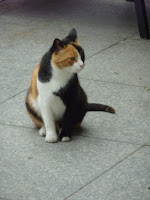In GOMA, we visited "We can make another future. Japanese art after 1989". There was a strong representation of work by Yayoi Kusama, but I particularly enjoyed "Soul under the moon" (2002), an installation using mirrors, ultra violet lights, water plastic, nylod thread, timber and synthetic polymer paint. The interactive piece had me thinking about infinity, illusions and phobias. It really is worth experiencing! The icing on the cake was the brilliant impromptu commentary by the guide. She really added to the experience!
Other favourite pieces were Takashi Mirakami' "Ant then, and then, and then, and then and then" (1984),
and Shigeo Toya's wonderful "Woods III" (1991-1992), which I would love to steal.
We also enjoyed the "Terrain Indigenous Australian Objects and Representations" exhibition which explored the work of indigenous Australian artists: paintings and spears,
(Hector Tjupura Burton, Willy Kaika, Mick Wikilyiri, Brenton Ken: "Kulata Tjuta (Many Spears) and Kulata (Spears)" 2014.
basket making, like these by Yvonne Koolmatrie,
adornments like this "Dancing Belt" by Lena Yarinkura (2005)
and sculptures, like these, which are amongst the "Bagu (Firestick Figures) and Jiman (Firesticks)" (2009), by Betty Andy, Daniel Beeron, Maureen Beeron, Nancy Beeron, Theresa Beeron, Nancy Cowan, Nephi Denham, Alison Murray, Doris Kinjun, Emily Murray, John Murray, Sally Murray, and Ninney Murray
and these "Jamu (Dog)" , 2003,by Lena Karinkura.
We also visited the "Creative Generation Excellence Awards in Visual Art" to catch up with the works of the 2014 senior visual arts students in Queensland. It was very different to the work of Victorian students I had seen earlier in the year. As usual, I was rather blown away by the talents of these high schoolers and the diversity of the pieces they created. This is Harrison Camino's "Rooftop"s
This piece is by Samantha Bowers and is called "Dental Record".
I particularly liked these two details from Kate Barham's "Sapos Encontrados".
I was also interested to see the presence of embroidery in this year's work. This detail is from Martha Godstone's "The Spontaneous Stitch".
My friend was very taken by Matilda Rodgers "Powerful Connections"
and I was taken by Drew Patterson's Obsession".
We also admired the exhibition of bright work by Kunmanara Williamson with collaborating artists Nita Williamsom and Suzanne Armstrong. This one is "Ngayuku ngura (My country) Pili Murpu (Mountain range)", 2012
We popped into the Queensland Art Gallery too. One exhibition is called Island Currents. I really found these performance objects from the Torres Strait islanders very inspiring: Alison Tabuai's "Wene-Wene/Gauguau Mawa (very powerful witchdoctor's mask)" 2001,
"Sikausagul (Dance of the Waves and Foam" dance instruments" (2011) by Yessie Mosby, Barnisha Mosby and Carolyn Mosby,
and George Nosby's incredible headdresses ( 2008).
The permanent collection of Australian art , which includes " From Dreamtime 2 Machinetime" (1979) by Trevor Nickolls is also worth seeing.
But, I was more interested in the Asian collection, especially the work by Indonesian artists, like Eko Nugroho
and Agung Kurniawan's works.
After all this, I was given a beautiful Vietnamese lunch at Viet De Lites, then we strolled through the Southbank gardens, spotting this replica of a Portuguese caravelle.
What a wonderful and multicultural day, Mia! Thank you. I am so lucky to have such generous friends!































































































